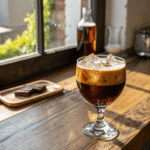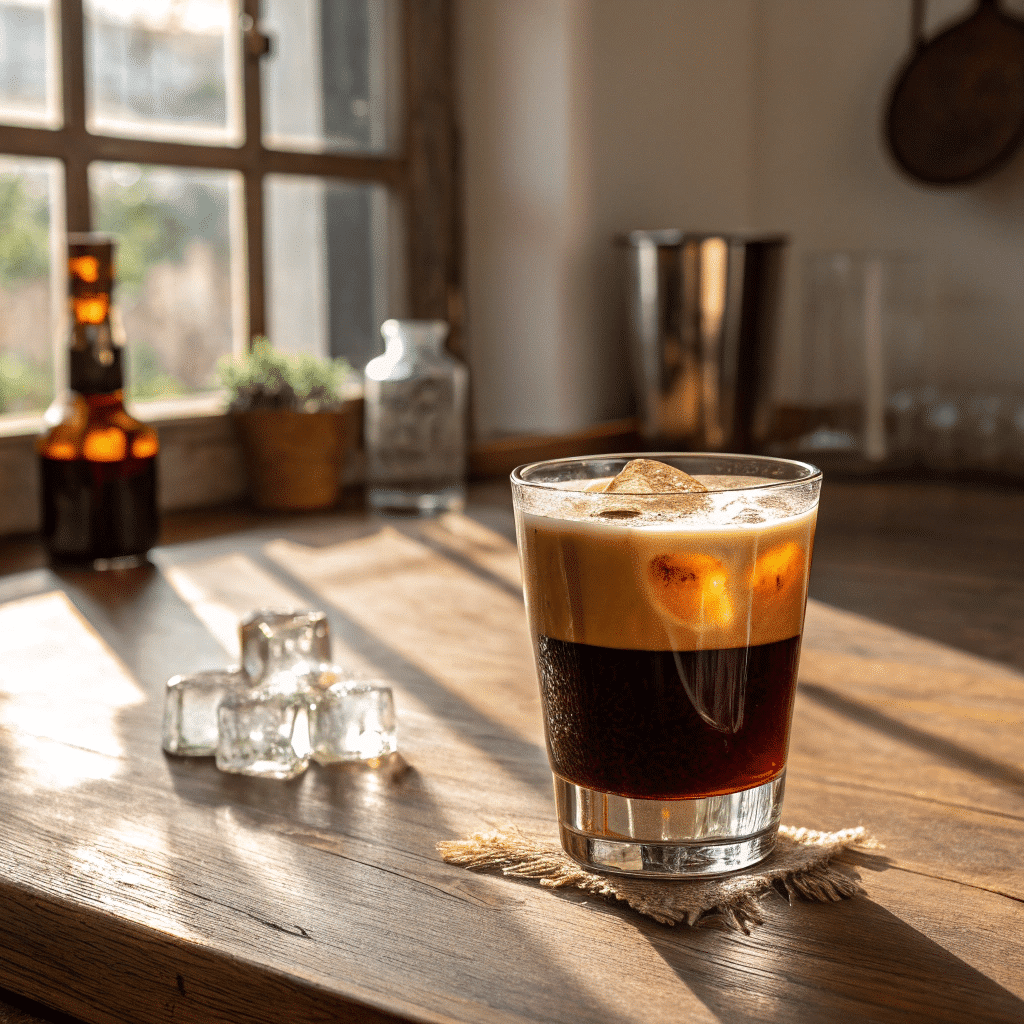Table of Contents
Table of Contents
If you’ve never tasted a Carajillo, you’re in for a treat. As Alice Thompson from Deliciousavors.com, I know that gathering in the kitchen is more than just about cooking it’s the stories we share with every dish. The Coffee cocktail perfectly fits this tradition, blending robust espresso with rich Spanish liqueur to create a drink as comforting as an old song.
I first encountered this cocktail on a slow afternoon, after a drive through Georgia’s winding roads. My aunt would pull espresso shots, then mix them with golden Licor 43 over ice, laughing as she handed out glasses. That moment captures everything I love about recipes they bring people together for a sip and a story. In this article,
I’ll guide you step by step through everything you need to know about this cocktail, including the best way to craft it, its origins, how it compares with similar drinks, and why it deserves a spot in your kitchen. As we dive in, you’ll also discover ways to make this classic your own and how to pair it perfectly with other favorites from Deliciousavors.com.
Introduction: The Story Behind Carajillo and What to Expect
Carajillo is more than a cocktail it’s a memory waiting to be made. This guide covers exactly how to prepare the iconic Coffee cocktail, the unique alcohol at its core, essential differences from similar cocktails like the martini and espresso, and tips for serving with flair. You’ll get insider tricks, serving suggestions, a handy recipe card, and related links from Deliciousavors.com to deepen your home bar game. Whether you’re a seasoned mixologist or a kitchen newbie, let’s pull up a chair and start shaking!
Print
Carajillo: Simple Guide to the Best Coffee Cocktail Experience
- Total Time: PT0H5M
- Yield: 1 drink
- Diet: Vegetarian
Description
Classic Carajillo blending espresso and Licor 43 for a smooth after-dinner cocktail.
Ingredients
2 oz Licor 43
2 oz freshly brewed espresso
Ice cubes
Espresso beans for garnish (optional)

Instructions
Étape 1: Fill a rocks glass with ice.
Étape 2: Pour Licor 43 over ice.

Étape 3: Gently add hot espresso atop Licor 43 to layer.
Étape 4: Serve immediately with or without stirring.
Étape 5: Garnish with espresso beans if desired.
Notes
Chill espresso for cold Carajillo.
Try decaf for a late-night version.
Layering provides a great visual and taste contrast.
- Prep Time: PT0H2M
- Cook Time: PT0H3M
- Category: Cocktail
- Method: Stirred or layered
- Cuisine: Spanish/Mexican
Crafting the Perfect Carajillo at Home
Secrets to Making a Proper Coffee cocktail Every Time
For a traditional coffee cocktail, balance is key. The classic recipe calls for equal parts espresso rich, freshly brewed, and still hot and Licor 43, a Spanish liqueur known for its smooth vanilla and citrus notes. Here’s how to do it:
- Fill a rocks glass with ice cubes.
- Pour 1½ to 2 ounces of Licor 43 over the ice.
- Gradually float a shot (about 2 ounces) of strong espresso or robust coffee on top. Pouring slowly over the back of a spoon helps achieve a beautiful layered effect and that signature creamy head.
- No need for cream; vigorous shaking or pouring over ice gives a foamy finish.
- For garnish, a few espresso beans provide a simple but elegant touch.
- For those late afternoons, decaf espresso works wonderfully for all the flavor without the buzz.
Pro Tips for a Memorable Coffee cocktail
- Experiment with your espresso strength and serving temperature. Chilled, layered Coffee cocktail offer a striking presentation, while a warm pour brings out cozy, spiced notes.
- Try a sugared rim for a special twist, especially if serving after dinner.
- Make your espresso just before serving for optimum flavor, or chill it in the fridge if you want a cold, refreshing treat.
Understanding the Spirit of this cocktail
What Kind of Alcohol Is in a Carajillo?
Licor 43 is the classic spirit found in this cocktail. This Spanish liqueur gets its name from the 43 natural ingredients that create its distinctive profile: golden in color, with aromatic vanilla, subtle citrus, and overtones of spice.
Unlike cocktails that use vodka or brandy, Licor 43 delivers a sweet, almost custard-like finish that complements espresso beautifully and delivers a warm, complex taste. The alcohol content is around 31% ABV, giving cocktail its smooth kick without being overwhelming.
Variations exist, but for the authentic experience, always reach for Licor 43. If you’re curious about other European bar staples, don’t miss my guides on Spanish Sangria and Iberian-Style Gin & Tonic for more ways to travel by taste.
Why Licor 43 Stands Out in Cocktails
- 43 select botanicals (including vanilla, citrus peel, and aromatic herbs)
- Sweeter, softer edge compared to coffee liqueurs like Kahlua
- Strong pairing with coffee, especially espresso, in hot or iced drinks

Comparing Carajillo with Martini and Espresso
Carajillo vs. Martini: What Sets Them Apart?
While both Carajillo and martini-based drinks like the Espresso Martini are coffee cocktails, they build distinctly different experiences:
| Carajillo | Espresso Martini | |
|---|---|---|
| Main Spirit | Licor 43 (or brandy in some regions) | Vodka & coffee liqueur |
| Coffee Base | Espresso or strong coffee | Espresso |
| Sweetness | Vanilla, citrus, and warm spice | Creamy, rich, often requires simple syrup |
| Serving Style | Over ice, rocks glass, layered or shaken | Shaken, frothy, martini glass |
| Occasion | After dinner, casual gatherings | Parties, upbeat events |
| Alcohol Content | Milder, smooth finish | More robust, stronger kick |
Coffee cocktail is the go-to for anyone who likes approachable, soulful drinks with a story, while the Espresso Martini draws fans looking for something bolder and more dramatic.
If you love unique spirits or want to explore more cocktail comparisons, see my breakdowns on Old Fashioned vs. Manhattan and Classic Mojito vs. Caipirinha.
Espresso vs. Carajillo: Beyond Caffeine
What’s the difference between a straight espresso and a Carajillo? Espresso is simply the concentrated coffee shot deep, bold, all about the bean. Carajillo transforms that base with Licor 43, adding sweetness and character, often served cold over ice as an after-dinner drink. While espresso jumpstarts your day, Coffee cocktail ends it with convivial conversation and a mellow, warming finish.
Elevating Your Carajillo: Variations, Pairings, and Pro Tips
Creative Coffee cocktail Variations to Try
Coffee cocktail shines with its classic combo, but it’s also a platform for playful twists:
- Switch Licor 43 for brandy or spiced rum for a deeper profile.
- Add a dash of cinnamon or orange zest for extra aromatics.
- For a dessert-style finish, try whipped cream topping and a sprinkle of cocoa.
For those who like a surprise in every glass, check out my Spiced Mexican Hot Chocolate and Sweet Potato Pecan Pie for more pairing ideas and twists on tradition.
Serving, Pairing, and Storing Coffee cocktail
Enjoy your Coffee cocktail immediately for the best taste ice keeps it crisp, and the espresso’s crema stays fresh for several minutes. Pair it with light desserts like biscotti, almond cake, or even churros for a full Spanish-inspired treat.
For big gatherings, prepare espresso in advance and chill. Assemble just before serving. Store any leftover Licor 43 in a cool, dark place.
Frequently Asked Questions
Q: How to make a proper Carajillo?
A: Start by adding 2 ounces of Licor 43 to ice in a rocks glass, then pour 2 ounces of hot espresso over the back of a spoon to create layers. It’s finished when the top gets foamy, and you can garnish with espresso beans.
Q: What kind of alcohol is in a Carajillo?
Q: What is the difference between a Carajillo and a martini?
Q: What is the difference between espresso and Carajillo?
A: Espresso is unsweetened, concentrated coffee served as a shot. Carajillo takes espresso and adds Licor 43 for a sweet, spiced, and spirited cocktail.
Carajillo: Key Differences Table
| Drink | Key Flavor/Notes | Main Spirit | Serving Style |
|---|---|---|---|
| Carajillo | Vanilla, citrus, smooth, lightly spicy | Licor 43 | Over ice, rocks glass |
| Espresso Martini | Creamy, bold, rich, coffee-forward | Vodka, coffee liqueur | Shaken, martini glass |
Conclusion
The Carajillo is a drink that invites experimentation and conversation. Simple, soulful, and full of flavor, it’s just as suited to solo relaxation as it is to lively gatherings with family and friends. With this guide, you’ll be able to craft a proper Coffee cocktail, appreciate its unique spirit, and understand how it compares to your other favorite coffee cocktails. Remember, every Carajillo is best enjoyed with a story and maybe just a touch of Southern charm.
For more recipes, visit my Facebook page.

4 thoughts on “Carajillo: Simple Guide to the Best Coffee Cocktail Experience”